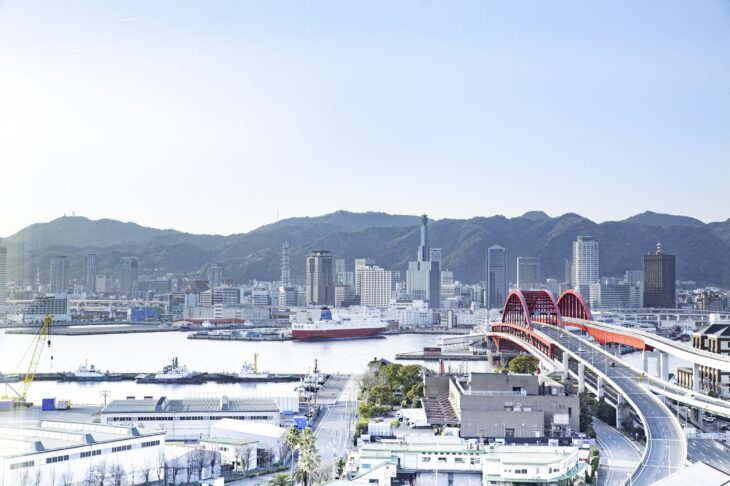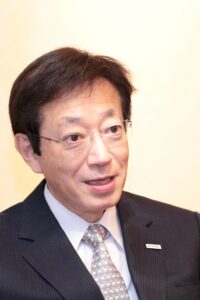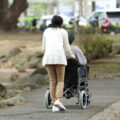Thirty Years after the 1995 Great Hanshin-Awaji Earthquake: Sustainable Urban Development Based on Lessons Learned from the Disaster

Photo: Courtesy of Kobe City Government
Hisamoto Kizo, Mayor of Kobe
It has been thirty years since the Great Hanshin-Awaji Earthquake occurred on January 17, 1995. At the time, the Kobe City Government quickly steered the city toward revitalization, and I think we have been able to recover and rebuild at a fairly fast pace. On March 17, just two months after the disaster, the city implemented the Urban Area Redevelopment Project. There was a lot of criticism because a large-scale urban redevelopment plan was proposed while many disaster victims were still living in evacuation centers. However, Kobe’s decision paid off, and three types of housing — disaster recovery and rental accommodation, as well as units in redeveloped urban areas — were quickly provided. As a result, the need for temporary housing was eliminated in less than five years.
Of course, not everything went quickly. Citizens were divided in their opinions about the earthquake reconstruction projects, and trial and error were repeated. In particular, the reconstruction of the area south of the JR Shin-Nagata Station, which was the most severely damaged, took 30 years. The project was finally completed on November 12, 2024, marked by the completion of the Shin-Nagata Campus Plaza.
Gains from rigorous administrative and financial reforms
While we were able to recover from the earthquake, new urban development with an eye to the future was put on hold. This was because the city’s finances were at an impasse. As a major city, Kobe naturally has a certain financial capacity. Nevertheless, recovering from the earthquake quickly used up any surplus, and we found ourselves in a situation where we might have been unable to repay our municipal bonds, even if we decided to issue them. At one point, the city was even on the verge of being designated as a financial reconstruction entity[1].
Therefore, Kobe City undertook a thorough administrative and financial reform. All projects other than those that dealt with reconstruction were canceled, and new projects were postponed. In addition, the number of municipal officers was significantly reduced. In the approximately 20 years between 1995, when the earthquake occurred, and 2015, their number decreased by 33%. This was more than double the national average for local governments.
This drastic reduction in personnel must have been difficult for the municipal officers. However, the shape of the Japanese society has changed in the past 30 years. The pace of population decline has far exceeded expectations, and it is clear that the labor shortage will accelerate. Right now, approx. 1.1 million people are entering their 20s every year, but this number will eventually drop to about 700,000. As we ask ourselves how we can continue providing administrative services with a limited number of municipal officers, I believe the experience that the Kobe City Government gained through these hardships will be a great asset in the coming era of severe population decline.
It was actually our fight against the pandemic that made me realize this. While each government was forced to respond with a small number of employees, Kobe fared better than other municipalities. We quickly developed a reservation system for vaccinations, and when vaccines suddenly stopped arriving from the government, we promptly set up a special center to handle cancellations.
Kobe also distributed the Special Cash Payments of 100,000 yen per person at one of the fastest rates among major cities. Even before the pandemic, Kobe had been actively recruiting digital transformation professionals from the private sector, which enabled us to quickly begin developing a new system to combat COVID-19 and overcome the crisis.
We are now entering an era in which we will not be able to increase the number of municipal officers, no matter how much we would want to do that. The strategies and tacit knowledge that Kobe has cultivated over the past 30 years of administrative and financial reforms will be useful in running our cities in the future.
Earthquakes cannot be predicted and can occur anywhere
The biggest lesson we learned from the Great Hanshin-Awaji Earthquake was that earthquakes are unpredictable and can happen anywhere. At the time, many of our citizens believed that earthquakes could not happen in Kobe. When I moved to Tokyo after high school, my mother would often ask me “How long do you intend to stay in that earthquakes-prone place? Earthquakes do not happen in Kobe.” I myself have no memory of experiencing an earthquake as a child.
Speaking about the disasters that occurred in Kobe, these were landslides, inundations of small and medium rivers, and storm surges caused by typhoons. The first of these that come to mind are the Great Hanshin Flood of 1938, which claimed over 600 victims in Kobe alone, and the 1967 Flood in which nearly 100 people died. Naturally, earthquakes were also included in Kobe’s regional disaster prevention plan, and there are records that some municipal officers were preparing for the scenario of an inland earthquake with an epicenter in Kobe, but this information was not shared with the municipal government at large. Thus, for our citizens, the Great Hanshin-Awaji Earthquake was a major disaster that struck suddenly, and brought about an unprecedented crisis.
I believe that part of the responsibility for our citizens’ belief that earthquakes could not happen in Kobe lies with the national government, which enacted the Act on Special Measures Concerning Countermeasures for Large-Scale Earthquakes in 1978. This act describes operations at the national level following a major earthquake, starting with the Director-General of the Japan Meteorological Agency issuing earthquake prediction information, which is then followed by the Prime Minister issuing a warning, which in turn leads to closure of highways, interruption of bullet train service, and beginning of evacuation. The disaster anticipated by this act was an earthquake in the Tokai region, off the coast of Suruga Bay. I believe that because of this act, the public was under the illusion that (1) earthquakes could be predicted, and (2) if an earthquake were to occur, it would be in the Tokai region, with the epicenter at sea off the coast of Suruga Bay.
However, since 1978, major earthquakes that actually occurred in Japan were the Great Hanshin-Awaji Earthquake, the Great East Japan Earthquake, the Kumamoto Earthquake, and the Noto Peninsula Earthquake. Naturally, we must also prepare for the Nankai Trough Earthquake and a major earthquake striking the Greater Tokyo Area, both of which are predicted to occur with a high degree of probability, and we should respect the expertise of seismologists.
Additionally, we have no way of knowing where or what kind of disaster will occur. We need to recognize that. The unexpected earthquake struck us under the influence of these preconceived notions and forced our citizens to desperately deal with the crisis in front of us. I hope that the lessons learned by the citizens of Kobe will be put to good use throughout the country.
Cities develop only when they are built on a resilient foundation
After all the hardships brought about by the Great Hanshin-Awaji Earthquake, we were determined to make sure that we never have to go through something similar again, and set out a goal of turning Kobe into a resilient city. In wake of a major earthquake, electricity, water, and gas supply gets interrupted, so you cannot even use the toilet. Having gone through this terrible experience, the Kobe City Government at the time first of all began the construction of a high-capacity water main. Over the course of 20 years, starting in 1996, the city has constructed this new water main, which now stores a large amount of water underground and provides temporary water supply in case of damage to the principal water supply system. It can provide drinking water for all of our citizens for 12 days. Even though it was a long-term project that would not have an immediate impact, it was started just one year after the earthquake. I have nothing but admiration for the speed with which the Kobe City Government made decisions at the time.
In wake of the earthquake, the Higashinada Wastewater Treatment Plant, one of the seven wastewater treatment plants in Kobe at the time, sustained catastrophic damage and was rendered inoperable for a long time. In response to this, we have established a network that allows other treatment plants to take over the workload of any treatment plant within the city, should one of them become inoperable.
For municipalities on the Pacific side of Japan, tsunami prevention in anticipation of the Nankai Trough Earthquake[2] is an urgent issue, and Kobe, which has been often affected by storm surges, has been rapidly building seawalls. Construction of seawalls that can withstand a once-in-a-thousand-years earthquake was completed in 2022, and a system for remote operation of flood gates is scheduled to be completed in FY2024. I heard that during the Great East Japan Earthquake, some firefighters who went to close the flood gates were swept away by the tsunami. I believe that remote operation systems can be effective in reducing human risks associated with disaster response.
The city has also installed a drainage system that pumps up rainwater when large amounts enter sewers in low-lying areas, and discharges it into rivers and the sea. The southern part of the Sannomiya district in downtown Kobe, which was often flooded until about a dozen years ago, has not suffered any damage since the system was installed.
We are also feeling the effects of continued landslide prevention efforts implemented by the national government, which began before the Great Hanshin-Awaji Earthquake. The soil of the Rokko Mountains, which run right through Kobe, consists of decomposed granite, which is prone to collapse. This is the same type of soil as that in Asaminami Ward of Hiroshima City, which suffered landslides in August 2014, and the area has seen many disasters throughout history. However, after the Great Hanshin Flood of 1938, which claimed hundreds of lives, the former Home Ministry established the Erosion Control Office, which continued building dams and planting trees to this day. Thanks to these efforts, heavy rains that hit western Japan in 2018, which were almost identical in scope to those that caused the Great Hanshin Flood, caused very little damage.
We tend to focus on glamorous, large-scale projects, but cities can only develop on a solid foundation. Installing a high-capacity water main underground and building a network of sewage treatment plants may be inconspicuous and unremarkable projects, but the proper development of such infrastructure will enhance cities’ disaster prevention capabilities and support their development. This is yet another lesson we have learned from the Great Hanshin-Awaji Earthquake.
To connect the memories of the earthquake
People often say that we cannot let the memory of the earthquake fade away, but it is natural for memories to fade over time, and conscious efforts are needed to pass them on. So, how can we pass on the knowledge that our municipal officers have gained from helping victims and carrying out recovery and reconstruction after the Great Hanshin-Awaji Earthquake?
Back in the day, under the guidance of veteran municipal officers, who know how things were at that time, we would role-play opening evacuation shelters and holding press conferences, but these days, we train using a disaster prevention game, called Crossroad[3].
In wake of the Great Hanshin-Awaji Earthquake, Kobe received a lot of support both from within Japan and all over the world, and we will be eternally grateful for this. Whenever a major disaster occurs in Japan, such as the Great East Japan Earthquake, the Kumamoto Earthquake or the Noto Peninsula Earthquake, we actively dispatch first municipal officers to help with the emergency response in the short term, and then urban development professionals to provide medium- to long-term assistance. After the Great East Japan Earthquake especially, veterans who had experienced the earthquake in Kobe in their youth, and young municipal officers with no such experience worked together as a team. I believe that through this tireless work together with local municipal officers, they passed on the knowledge of what it is like to support an area that was struck by a disaster. At the time of the Great Hanshin-Awaji Earthquake, we also received much assistance from citizen volunteers, and various NPOs have been established in Kobe too. The Kobe City Government strives to provide logistical support to these independent activities, born out of people’s own experiences and ideas.
It is also important to pass on these memories to the next generation. The City of Kobe provides elementary and junior high school students with a supplemental textbook for disaster prevention education, called Shiawase Hakobo (Let’s bring happiness!) and created by the Municipal Board of Education. This title is based on the song Shiawase Hakoberu Yo Ni (To Bring Happiness), which was written and composed by Usui Makoto, an elementary school teacher, immediately after the earthquake. This song has become so ingrained in the souls of our citizens that each and every one of them can sing it now, and in the hope that it will be sung in perpetuity, we made it our official city anthem in 2021. We want children, who do not know about the Great Hanshin-Awaji Earthquake to become adults, who think and act for themselves.
Creating truly sustainable cities with a long-term perspective
As a result of significant expenditure reduction, our finances have recovered, and for the last decade or so we have finally been able to undertake new development projects. Right now, we are working on achieving truly sustainable urban development, and regulations for the construction of high-rise apartment complexes, which came into effect in July 2020, are part of these efforts. Construction of high-rise apartment complexes with individually owned units is expected to drive a short-term increase in population, but I believe that it would become a detriment to the city at large. If no restrictions were imposed, the construction of high-rise apartment complexes in Kobe would concentrate in the downtown Sannomiya area, and if many residents of those new units were to work in the neighboring Osaka, Kobe would quickly become a commuter town, and Sannomiya’s shopping, dining, and arts scene would inevitably decline.
With its mountains close to the sea and a narrow habitable area, Kobe has been cutting down mountains and reclaiming land from the sea to build new suburbs, roads and subway lines since before the period of high economic growth. However, due to the city’s financial crisis after the Great Hanshin-Awaji Earthquake, these areas were neglected and now have a dated feel to them. If high-rise apartment complexes were to be built, more people would move into them, accelerating the deterioration and depopulation of suburbs.
A city’s sustainability can be enhanced by looking at its development from a long-term perspective, rather than focusing on short-term population growth. In a society with a declining population, we should make effective use of existing assets, rather than building new housing and infrastructure. Instead of simply making our cities beautiful, we should create places to work, such as co-working spaces, turning them into places very different from commuter towns – places where people can create new lifestyles, and where they can live close to their place of work.
In addition, we will create a cycle in which residents themselves are involved in the management of the surrounding satoyama[4] areas. Unlike the Shiretoko Peninsula, Shirakami-Sanchi or Yakushima Island, these areas are not untouched wilderness, but rather maintained by continued human intervention. If left unattended, they will soon turn into dark broadleaf evergreen forests.
The downtown, suburbs and satoyama areas – by promoting the revitalization of these three areas using new ideas, we hope to create a truly sustainable city. This is the vision of Kobe, 30 years after the Great Hanshin-Awaji Earthquake.
Translated from “Hanshin-Awaji Daishinsai kara 30-nen: Shinsai no Kyokun wo Ikashita Jizokukano na Machizukuri (Thirty Years after the 1995 Great Hanshin-Awaji Earthquake: Sustainable Urban Development Based on Lessons Learned from the Disaster),” Chuokoron, February 2025, pp. 142–147 (Courtesy of Chuo Koron Shinsha) [February 2025]
[1] This refers to local governments that have to undergo financial reconstruction under the national government, because their financial situation has deteriorated to the point where they cannot do this independently.
[2] Along the Nankai Trough (approximately 700 km from offshore Shizuoka Prefecture to offshore Miyazaki Prefecture), massive earthquakes of magnitude 8 or higher occur repeatedly at roughly 100-150-year intervals.
[3] Crossroad is a tabletop training card game developed by Team Crossroad with the aim of improving the disaster response capabilities of municipal officers. Questions are presented asking how to act in the event of a disaster, such as “Should pets be accepted into evacuation shelters?” and participants give a “Yes” or “No” answer. By discussing the reasons and impacts behind each option, participants can learn the importance of decision-making.
[4] Satoyama refers to areas consisting of farmlands, ponds, forests and grasslands around human settlements.
Keywords
- Hisamoto Kizo
- Mayor
- Kobe
- Kobe City Government
- Great Hanshin-Awaji Earthquake
- January 17, 1995
- revitalization
- recovery
- redevelop
- housing
- Urban Area Redevelopment Project
- Shin-Nagata Campus Plaza
- population decline
- labor shortage
- high-capacity water main
- water supply
- flood
- landslide prevention
- Great Hanshin Flood
- sewage treatment plants
- volunteers
- NPOs
- Shiawase Hakoberu Yo Ni
- sustainable urban development
- sustainable city
- satoyama





